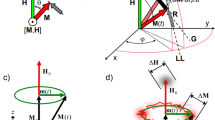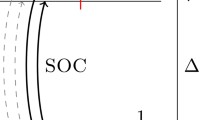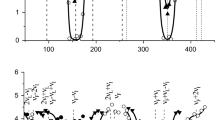Abstract
A simple semi-classical model of magnetization dynamics based on Landau-Lifshits equation of motion with anisotropic effective g-tensor and anisotropic spin relaxation is proposed and applied to the case of electron paramagnetic resonance (EPR). In the Faraday geometry, the model predicts polarization effect consisting in strong dependence of the EPR line shape and magnitude on orientation of vector h of oscillating magnetization with respect to the crystal structure, so that EPR may be suppressed for some directions of h. The EPR with anisotropic parameters possesses specific magnetic oscillations, which are different from standard circular rotation of the magnetization vector around the direction of external magnetic field. In general case, the trajectory of the magnetization vector end is either elongated quasi-ellipse, the position of the main axis of which depends on the magnitude of the external magnetic field, or magnetic oscillations may acquire almost linear character. The model is successfully applied for the quantitative accounting of the polarization effect for EPR mode observed in CuGeO3 doped with 2% of Co impurity, which remained unexplained for more than 15 years.





Similar content being viewed by others
References
A. Abragam, B. Bleaney, Electron Paramagnetic Resonance of Transition Ions (Clarendon Press, Oxford, 1970)
S.V. Demishev, A.V. Semeno, H. Ohta, S. Okubo, I.E. Tarasenko, T.V. Ishchenko, N.E. Sluchanko, Pis’ma v ZhETF 84, 305 (2006)
S.V. Demishev, A.V. Semeno, H. Ohta, S. Okubo, I.E. Tarasenko, T.V. Ishchenko, N.A. Samarin, N.E. Sluchanko, Phys. Solid State 49, 1295 (2007)
A.V. Semeno, H. Ohta, S. Okubo, N.E. Sluchanko, I.E. Tarasenko, A.V. Kuznetsov, T.V. Ishchenko, S.V. Demishev, Appl. Magn. Reson. 33, 3 (2008)
A.G. Gurevich, G.A. Melkov, Magnetization Oscillations and Waves (Fizmatlit, Moscow, 1994 (CRC, New York, 1996)
M. Oshikawa, I. Affleck, Phys. Rev. Lett. 25, 5136 (1999)
M. Oshikawa, I. Affleck, Phys. Rev. B: Condens. Matter 65, 134410 (2002)
S. Miyashita, T. Yoshino, A. Ogasahara, J. Phys. Soc. Jpn. 68, 655 (1999)
Y. Natsume, F. Sasagawa, M. Toyoda, I. Yamada, J. Phys. Soc. Jpn. 48, 50 (1980)
I. Yamada, Y. Natsume, J. Phys. Soc. Jpn. 48, 58 (1980)
Y. Natsume, F. Noda, F. Sasagawa, H. Kanzawa, J. Phys. Soc. Jpn. 52, 1427 (1983)
S.V. Demishev, A.V. Semeno, H. Ohta, Appl. Magn. Reson. 52, 379 (2021)
A.G. Maryasov, M.K. Bowman, J. Magn. Reson. 221, 69 (2012)
A.G. Maryasov, M.K. Bowman, J. Magn. Reson. 233, 80 (2013)
M.M. Glazov, E.L. Ivchenko, Semiconductors 42, 951 (2008)
M. Mostovoy, D. Khomskii, J. Knoester, Phys. Rev. B 58, 8190 (1998)
Funding
This research did not receive any specific grant from funding agencies in the public, commercial, or not-for-profit sectors.
Author information
Authors and Affiliations
Contributions
SVD and AVS: wrote the text and designed figures. SVD: proposed the model and analyzed it general properties. AVS: applied the proposed model for explaining of the experimental data for CuGeO3 crystals doped with Co impurity.
Corresponding author
Ethics declarations
Conflict of Interest
The authors declare no competing financial or non-financial interests.
Additional information
Publisher's Note
Springer Nature remains neutral with regard to jurisdictional claims in published maps and institutional affiliations.
Rights and permissions
Springer Nature or its licensor holds exclusive rights to this article under a publishing agreement with the author(s) or other rightsholder(s); author self-archiving of the accepted manuscript version of this article is solely governed by the terms of such publishing agreement and applicable law.
About this article
Cite this article
Demishev, S.V., Semeno, A.V. Polarization Effect in Electron Paramagnetic Resonance with Anisotropic Effective G-Tensor and Anisotropic Spin Relaxation. Appl Magn Reson 53, 1505–1516 (2022). https://doi.org/10.1007/s00723-022-01487-7
Received:
Revised:
Accepted:
Published:
Issue Date:
DOI: https://doi.org/10.1007/s00723-022-01487-7




